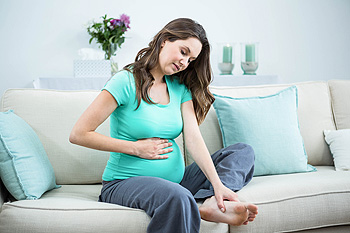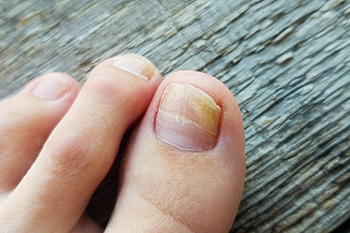Items filtered by date: January 2023
Treatments for Plantar Fibroma

Patients who notice a lump on the sole of their foot will often visit a podiatrist for a proper diagnosis. It may be a plantar fibroma, which develops in the plantar fascia along the bottom of the foot. A plantar fibroma is considered to be a rare and benign condition but it can be painful as shoes that are worn press against the offending lump. Additionally, pain and discomfort may be felt when standing for extended periods, or when walking barefoot. Research has indicated there is no cure for this condition so many patients will take steps to reduce the pain. This may be achieved by using oral or injected steroids, in addition to extracorporeal shockwave therapy, known as ESWT. If you have this condition, it is strongly urged that you are under the care of a podiatrist who can determine the best course of treatment.
A plantar fibroma may disrupt your daily activities. If you have any concerns, contact Harvey Jacobs, DPM of Quality Foot Care Center. Our doctor can provide the care you need to keep you pain-free and on your feet.
Plantar Fibroma
A plantar fibroma is a fibrous knot in the arch of the foot. It is embedded in the plantar fascia which is a band of tissue that extends from the heel to the toes along the bottom of the foot. There can be multiple plantar fibromas in the feet at the same time. There are no known causes for this condition. If you have a plantar fibroma, there will be a bump in the arch of your foot that cannot be missed. Any associated pain is most often due to a shoe rubbing against the nodule. Non-surgical options, such as steroid injections, physical therapy, and orthotics should be tried first. Surgery is a last resort and is the only thing that will remove a plantar fibroma entirely. Consult with a podiatrist for a proper diagnosis and to determine the treatment regimen that is right for you.
What Causes a Plantar Fibroma?
While there are no specific causes identified, a plantar fibroma can possibly come from genetic predisposition or the formation of scar tissue that forms from healing the tears in the plantar fascia.
What Are the Symptoms of a Plantar Fibroma?
There will be a noticeable lump in the arch of the foot that may or may not cause pain. If pain is felt, it is typically because a shoe is rubbing up against the lump or when walking or standing barefoot.
Treatment and Prevention
A plantar fibroma will not disappear without treatment, but it can get smaller and be a non-issue. If pain persists, a podiatrist examines the foot and when the arch of the foot is pressed, pain can be felt down to the toes. An MRI or biopsy might be performed to help diagnose or evaluate the plantar fibroma. The following non-surgical options are generally enough to reduce the size and pain of these nodules:
- Steroid injections
- Orthotics
- Physical therapy to help apply anti-inflammatory creams on the bump
Surgery is considered if the mass increases in size and the patient continues to feel pain after non-surgical methods are tried.
If you have any questions please feel free to contact our office located in Somerset, NJ . We offer the newest diagnostic tools and technology to treat your foot and ankle needs.
Is Athlete's Foot Contagious?

The foot condition known as athlete’s foot is quite common, and it is considered to be contagious. Many people may notice symptoms but choose to ignore them until they become severe. These symptoms can include itchiness between the toes, redness, and flaky patches that may develop on various parts of the foot. In severe cases, small blisters may form and this can cause discomfort. Athlete’s foot is caused by a fungus that lives in moist areas like public swimming pools and locker rooms. Effective prevention methods are refraining from sharing shoes, towels, and socks. Wearing appropriate shoes is advised while in these types of environments. Research has shown that athlete’s foot will not improve without treatment and it is strongly urged that you are under the care of a podiatrist if you are afflicted with this condition.
Athlete’s foot is an inconvenient condition that can be easily reduced with the proper treatment. If you have any concerns about your feet and ankles, contact Harvey Jacobs, DPM from Quality Foot Care Center. Our doctor will treat your foot and ankle needs.
Athlete’s Foot: The Sole Story
Athlete's foot, also known as tinea pedis, can be an extremely contagious foot infection. It is commonly contracted in public changing areas and bathrooms, dormitory style living quarters, around locker rooms and public swimming pools, or anywhere your feet often come into contact with other people.
Solutions to Combat Athlete’s Foot
- Hydrate your feet by using lotion
- Exfoliate
- Buff off nails
- Use of anti-fungal products
- Examine your feet and visit your doctor if any suspicious blisters or cuts develop
Athlete’s foot can cause many irritating symptoms such as dry and flaking skin, itching, and redness. Some more severe symptoms can include bleeding and cracked skin, intense itching and burning, and even pain when walking. In the worst cases, Athlete’s foot can cause blistering as well. Speak to your podiatrist for a better understanding of the different causes of Athlete’s foot, as well as help in determining which treatment options are best for you.
If you have any questions please feel free to contact our office located in Somerset, NJ . We offer the newest diagnostic and treatment technologies for all your foot and ankle needs.
Foot Pain Relief During Pregnancy

Foot pain can be common among pregnant women. This may be a result of the added weight that is gained from the growing fetus, and the feet may become swollen and achy. There are simple methods that can be implemented which can provide moderate relief. Elevating the feet as often as possible and avoiding standing for long periods at a time are generally successful in controlling foot pain from pregnancy. Many women enjoy getting foot massages during their pregnancy, and performing specific stretches can help aching feet. Additionally, it is beneficial to wear shoes that have a lower heel and are comfortable, and wearing cotton socks may help the feet to breathe. Pregnancy can bring joy and happiness, and it is suggested that a podiatrist be consulted who can treat existing foot pain, allowing fuller enjoyment during this time.
Pregnant women with swollen feet can be treated with a variety of different methods that are readily available. For more information about other cures for swollen feet during pregnancy, consult with Harvey Jacobs, DPM from Quality Foot Care Center. Our doctor will attend to all of your foot and ankle needs.
What Foot Problems Can Arise During Pregnancy?
One problem that can occur is overpronation, which occurs when the arch of the foot flattens and tends to roll inward. This can cause pain and discomfort in your heels while you’re walking or even just standing up, trying to support your baby.
Another problem is edema, or swelling in the extremities. This often affects the feet during pregnancy but tends to occur in the later stages.
How Can I Keep My Feet Healthy During Pregnancy?
- Wearing orthotics can provide extra support for the feet and help distribute weight evenly
- Minimize the amount of time spent walking barefoot
- Wear shoes with good arch support
- Wear shoes that allow for good circulation to the feet
- Elevate feet if you experience swelling
- Massage your feet
- Get regular, light exercise, such as walking, to promote blood circulation to the feet
If you have any questions please feel free to contact our office located in Somerset, NJ . We offer the newest diagnostic and treatment technologies for all your foot and ankle needs.
Reminder: When Was the Last Time...?
How Is Toenail Fungus Treated?

Fungal infections commonly affect the toenails. Research has shown that approximately 14 percent of the population nationwide suffers from this fungus, and it can be a stubborn ailment to treat. The fungus that causes toenail fungus enters the body through small cracks in the skin on the feet. These fungi live and thrive in warm and moist environments, such as shower room floors and public swimming pools. The most common type of fungus that affects the toes is called tinea unguium, and it is caused by dermatophytes. Athlete’s foot is also caused by this fungus and can be uncomfortable and unsightly. Toenail fungus is often treated with topical medications, and oral pills may be prescribed. Having laser treatment performed is an option that many people choose, and it may be successful and painless in treating this condition. If you are afflicted with toenail fungus, it is strongly suggested that prompt medical attention is received from a podiatrist who can determine which type of treatment is best for you.
For more information about treatment, contact Harvey Jacobs, DPM of Quality Foot Care Center. Our doctor can provide the care you need to keep you pain-free and on your feet.
Toenail Fungus Treatment
Toenail fungus is a condition that affects many people and can be especially hard to get rid of. Fortunately, there are several methods to go about treating and avoiding it.
Antifungals & Deterrence
Oral antifungal medicine has been shown to be effective in many cases. It is important to consult with a podiatrist to determine the proper regiment for you, or potentially explore other options.
Applying foot powder on the feet and shoes helps keep the feet free of moisture and sweat.
Sandals or open toed shoes – Wearing these will allow air movement and help keep feet dry. They also expose your feet to light, which fungus cannot tolerate. Socks with moisture wicking material also help as well.
If you have any questions please feel free to contact our office located in Somerset, NJ . We offer the newest diagnostic tools and technology to treat your foot and ankle needs.
Types and Causes of Sports Related Injuries

There are two main categories of sports related injuries consisting of an acute foot, ankle, or toe injury that happens suddenly, while a chronic injury develops over time. Examples of acute sports injuries include twisting an ankle, taking a blow to the toe, foot or ankle, and breaking a bone. Most chronic injuries are caused by overuse of a joint or a particular area of the body, such as stress fractures or plantar fasciitis. Among the most common risk factors for incurring a sports related injury are using the wrong type of equipment, overtraining, and wearing shoes that do not give the proper protection for your feet. Other risk factors include having endured a previous injury, and running or jumping on hard surfaces. Additionally, failing to properly warm up and cool down after running or playing may lead to incurring an injury. Treatment for an acute injury generally requires immediate medical attention, and depending on the severity of the injury, a longer healing time may be necessary. For chronic injuries, the first recommendation is to cease the activity that caused the condition. In either case, if you have sustained an injury to the toes, feet, or ankles, it is a good idea to contact a podiatrist for a complete examination and treatment options.
Ankle and foot injuries are common among athletes and in many sports. They can be caused by several problems and may be potentially serious. If you are feeling pain or think you were injured in a sporting event or when exercising, consult with Harvey Jacobs, DPM from Quality Foot Care Center. Our doctor will assess your condition and provide you with quality foot and ankle treatment.
Common Injuries
The most common injuries that occur in sporting activities include:
- Achilles Tendonitis
- Achilles Tendon Rupture
- Ankle Sprains
- Broken Foot
- Plantar Fasciitis
- Stress Fractures
- Turf Toe
Symptoms
Symptoms vary depending upon the injury and in some cases, there may be no symptoms at all. However, in most cases, some form of symptom is experienced. Pain, aching, burning, bruising, tenderness, tightness or stiffness, sensation loss, difficulty moving, and swelling are the most common symptoms.
Treatment
Just as symptoms vary depending upon the injury, so do treatment options. A common treatment method is known as the RICE method. This method involves rest, applying ice, compression and elevating the afflicted foot or ankle. If the injury appears to be more serious, surgery might be required, such as arthroscopic or reconstructive surgery. Lastly, rehabilitation or therapy might be needed to gain full functionality in the afflicted area. Any discomfort experienced by an athlete must be evaluated by a licensed, reputable medical professional.
If you have any questions, please feel free to contact our office located in Somerset, NJ . We offer the newest diagnostic and treatment technologies for all your foot care needs.

